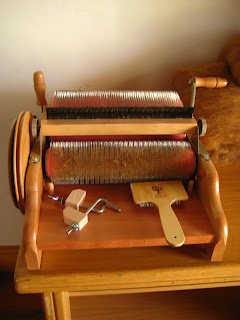Above: This is a mechanical carding machine, known as a drum carder. It can be used to process hair, wool, or vegetable fibers such as cotton.
The drum carder straightens the fibers and aligns them so that the fiber can be spun more easily. During the carding process, different colors of hair, wool or cotton can be combined to created a variegated color scheme. Once spun, the multi-colored yarn can be knitted, crocheted or woven to create a marbled effect.
Above: On the left of the picture you can see the hand-crank mechanism of the drum carder. In the background is carded fiber, ready for spinning.
Above: It seems that although there are a number of tools that can be used with a carder, this paddle brush is the most useful, and can either be used to encourage the fiber to lie straight, or to remove leftover fiber from the drum.
Above: Hand-powered machines fascinate me. My generation is accustomed to plugging everything in, which has made us complacent. We aren't aware of how much energy we would use to complete even simple tasks. It's refreshing, and reassuring, to know that man-powered mechanisms are still being produced and used.
Fiber processing puts me in mind of a time when women used to sit together doing women's work. It was laborious, time-consuming work, but I believe the result was very satisfying for these women. It was a time in which the product of their labor was visual proof of human effort; the difference between each woman's workmanship a signature, that mom, or aunty or grandma (or all of them) had crafted that item, just for you, from scratch.
I'm really looking forward to learning this, and other, fiber processing skills.




No comments:
Post a Comment